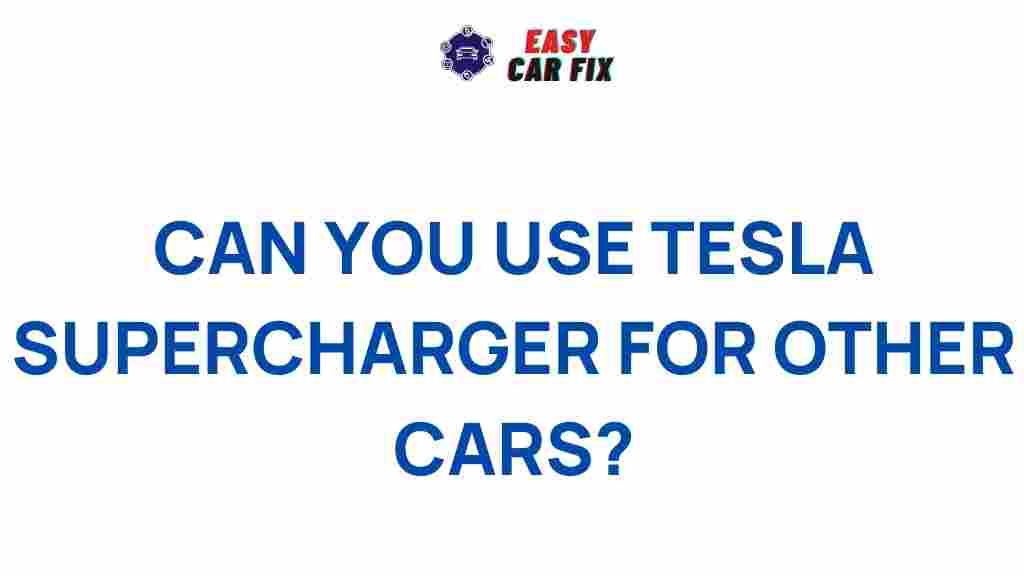Unleashing the Power: Tesla Supercharger Compatibility with Other Vehicles
As the electric vehicle (EV) market continues to grow, charging infrastructure has become a key component in promoting widespread adoption. Among the various charging solutions available, Tesla’s Supercharger network stands out for its rapid charging capabilities and extensive coverage. However, many potential EV owners wonder about the compatibility of Tesla Superchargers with vehicles from other manufacturers. In this article, we will explore Tesla’s innovative technology, the compatibility of their Superchargers, and how this affects the broader landscape of electric vehicles.
The Importance of Charging Stations
Charging stations are essential for the success of electric vehicles. They not only provide the necessary power to keep EVs running but also influence driver confidence and convenience. Here’s why charging stations, particularly Tesla Superchargers, are crucial:
- Accessibility: A widespread network of charging stations ensures that drivers can recharge their vehicles without significant detours.
- Speed: Superchargers can charge an EV much faster than standard charging stations, making long-distance travel more feasible.
- Cost-Effectiveness: Tesla offers competitive pricing for Supercharging, which can be cheaper than gasoline over time.
Understanding Tesla Supercharger Technology
Tesla Superchargers utilize a proprietary charging technology that allows for rapid charging of their electric vehicles. Here are some key features of Tesla’s charging system:
- High Voltage: Tesla Superchargers operate at higher voltages, which significantly reduces charging time.
- Direct Current (DC) Fast Charging: Unlike standard Level 2 chargers that use alternating current (AC), Superchargers deliver DC directly to the battery, resulting in faster charging times.
- Smart Charging: Tesla’s charging technology includes software that optimizes charging speed and efficiency based on battery conditions and power availability.
Exploring Compatibility with Other Electric Vehicles
One of the pressing questions for EV owners is whether Tesla Superchargers are compatible with vehicles from other manufacturers. The answer is nuanced and depends on several factors.
Current Compatibility Status
As of now, Tesla Superchargers are primarily designed for Tesla vehicles. However, Tesla has begun to explore options for opening its Supercharger network to non-Tesla electric vehicles in certain regions. Here’s what you need to know:
- Plug Types: Tesla vehicles use a unique connector for charging, which differs from the standards used by many other manufacturers (like CCS or CHAdeMO). This means that non-Tesla vehicles typically cannot use Superchargers without an adapter.
- Pilot Programs: In some countries, Tesla has initiated pilot programs allowing select non-Tesla vehicles to access Superchargers. For example, in parts of Europe, Tesla has started to allow certain EVs to use its network.
- Adapters: Some third-party solutions and adapters are emerging, which may offer compatibility for other electric vehicles, but these are not officially endorsed by Tesla.
Benefits of Supercharger Compatibility
Improving compatibility with other electric vehicles could have several advantages:
- Increased Charging Options: Non-Tesla EV owners would benefit from access to the extensive Supercharger network.
- Enhanced EV Adoption: Broader compatibility could encourage more drivers to switch to electric vehicles, knowing they have access to reliable and fast charging.
- Network Utilization: Superchargers could see higher usage rates, improving the return on investment for Tesla’s infrastructure.
Step-by-Step Process: How to Charge at a Tesla Supercharger
If you are a Tesla owner or are considering using a Tesla Supercharger, here’s how to charge at a Supercharger station:
- Locate a Supercharger: Use the Tesla app or in-car navigation to find the nearest Supercharger station.
- Plug In: Park your vehicle in a designated Supercharger spot and connect the charging cable to your Tesla.
- Start Charging: The charging process will begin automatically, and you can monitor the progress on the car’s display or through the Tesla app.
- Payment: Payment is typically processed automatically via your Tesla account, so you don’t need to do anything extra.
- Disconnect: Once charging is complete, unplug the cable and return it to the station.
Troubleshooting Tips for Tesla Supercharger Users
While Tesla Superchargers are generally reliable, you may encounter some issues. Here are some troubleshooting tips:
- Check Availability: Before heading to a Supercharger, confirm that it’s available and operational via the Tesla app.
- Inspect the Connector: Ensure that the charging connector is clean and free of debris to avoid poor connections.
- Monitor Charging Status: If charging stops unexpectedly, check the display for error messages and follow the prompts.
- Contact Support: If you continue to experience issues, contact Tesla’s customer support for assistance.
Future of Supercharger Compatibility
The future of Tesla Supercharger compatibility with other vehicles looks promising. Several factors could contribute to expanding access:
- Industry Collaboration: As the electric vehicle market matures, manufacturers may work together to standardize charging technologies.
- Legislation and Incentives: Government policies promoting EV adoption may encourage broader access to charging networks.
- Technological Advancements: Innovations in charging technology could lead to more flexible and adaptable charging solutions.
Conclusion
Tesla’s Supercharger network represents a significant advancement in the realm of electric vehicle technology. While current compatibility with non-Tesla vehicles is limited, the potential for future access is exciting. As more electric vehicles hit the road and charging infrastructure evolves, it’s vital for manufacturers to consider interoperability to enhance the user experience and promote EV adoption.
For more information on Tesla’s Supercharger network and its innovative technology, visit Tesla’s official site.
By understanding the capabilities and limitations of Tesla Superchargers, both Tesla and non-Tesla EV owners can make informed decisions on their charging needs, ensuring that they can take full advantage of the growing network of charging stations.
This article is in the category SmartBuy and created by EasyCarFix Team

4 thoughts on “Unleashing the Power: Tesla Supercharger Compatibility with Other Vehicles”